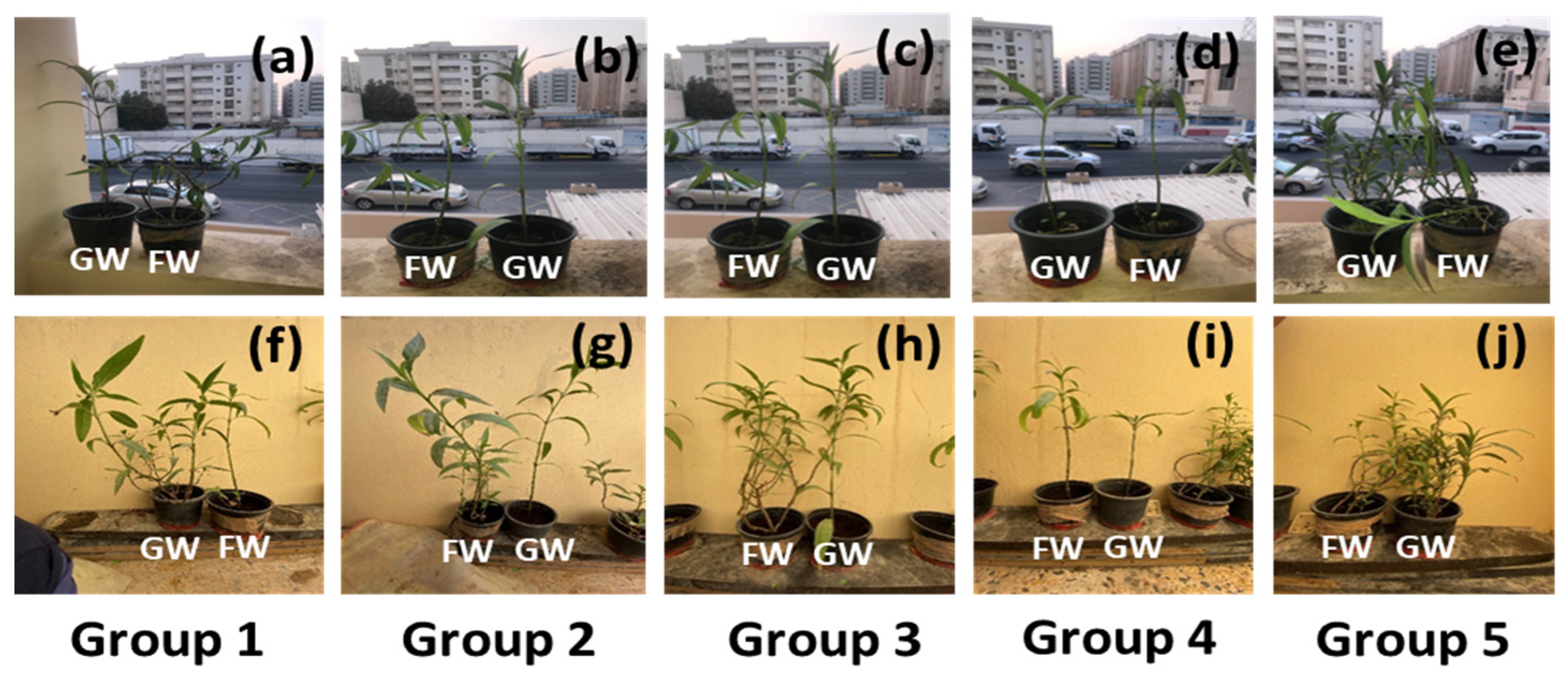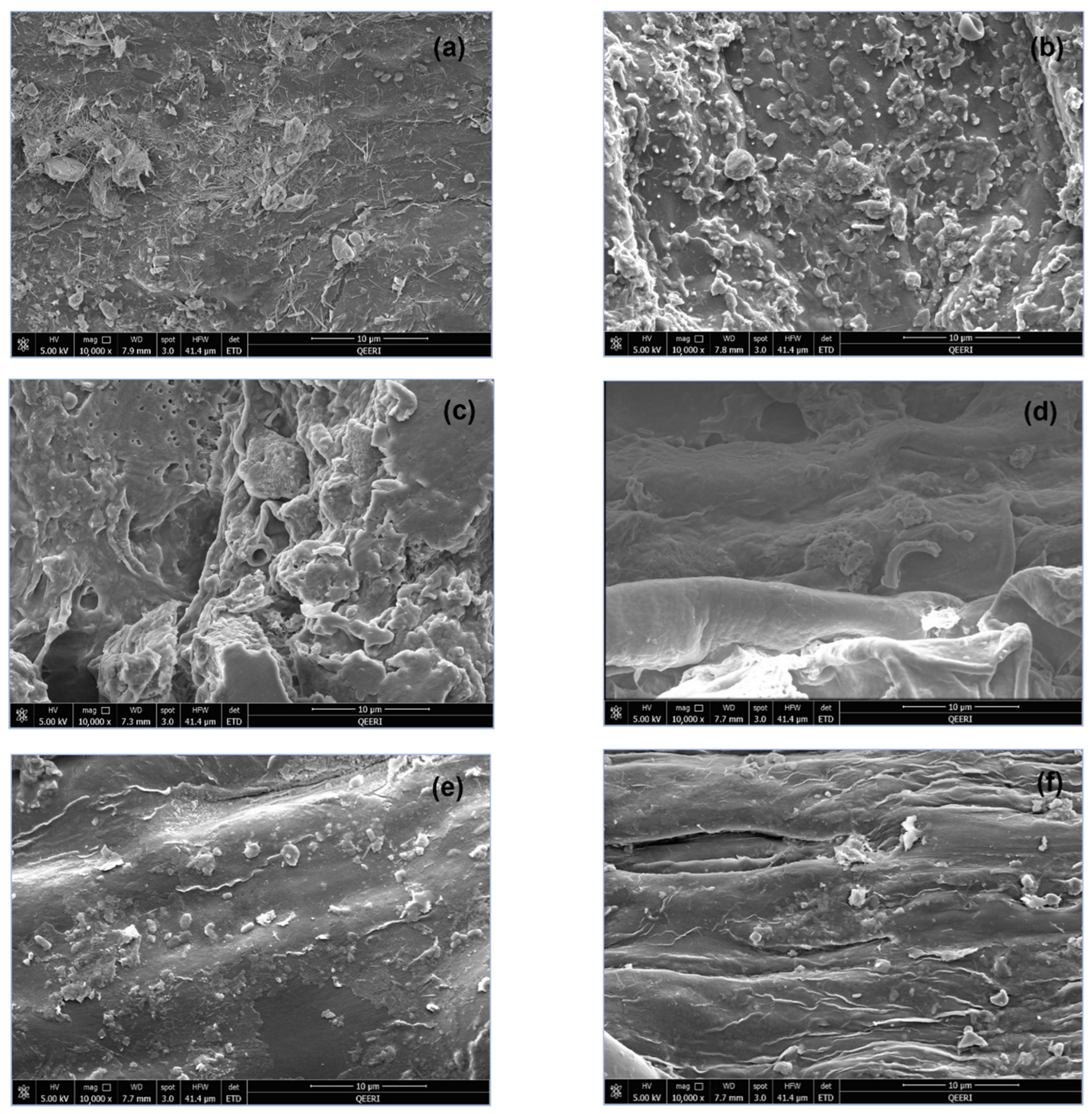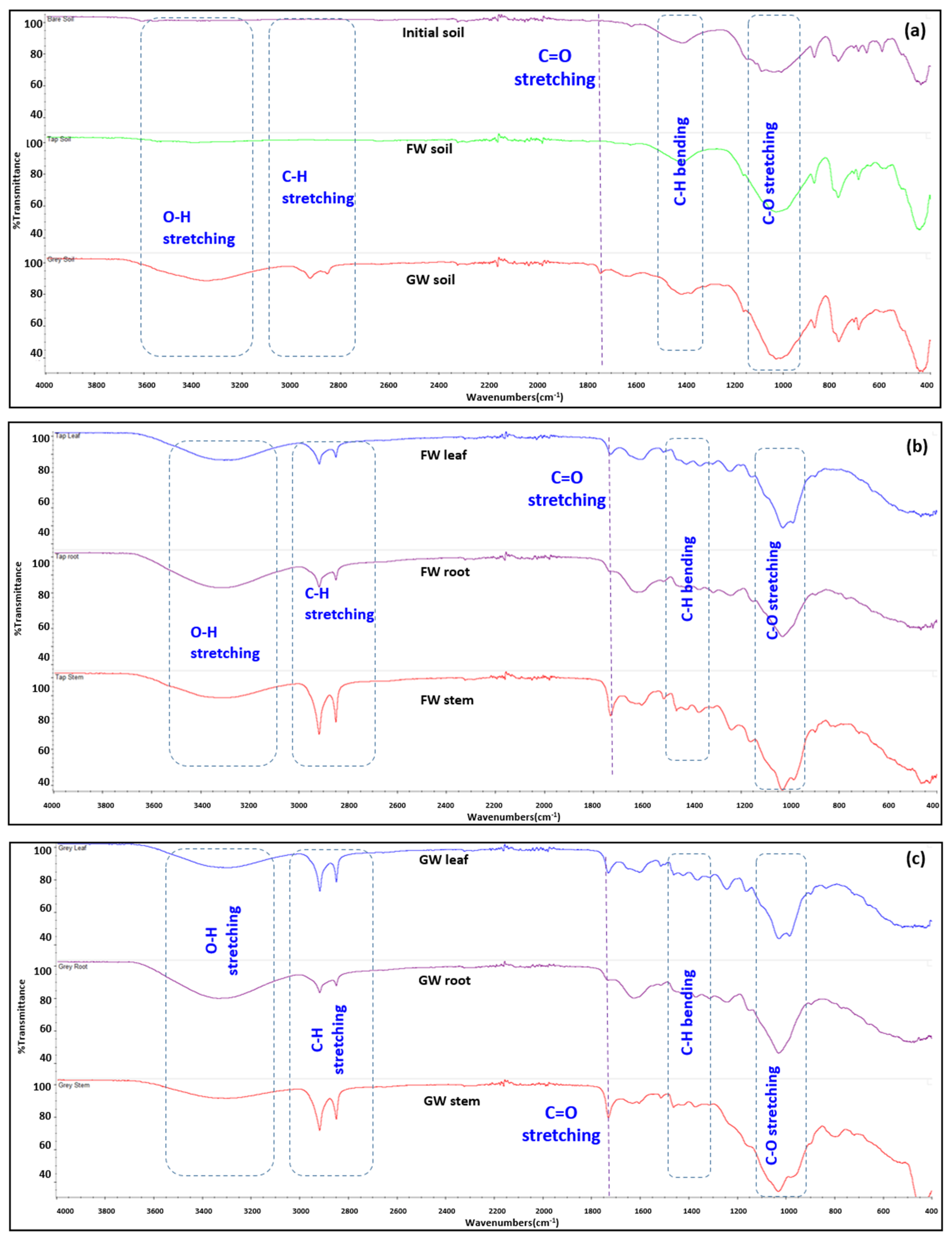Evaluation of Greywater as a Sustainable Source of Irrigation for Ornamental Crops in Green Walls—A Study of Plant and Soil Using Ruellia tuberosa
Abstract
1. Introduction
2. Materials and Methods
2.1. Plant and Media Selection
2.2. Media Characterisation
2.3. Greywater Recipe and Characterization
2.4. Plant Characterisation
2.5. Plant Biomass
2.6. Statistical Analysis
3. Results and Discussion
3.1. Characteristics of Greywater and Media
3.2. Plant Morphological and Biomass Characteristics
3.3. Soil Biofilm and Plant Biomass Imaging and Spectroscopy
3.4. Elemental Analysis for Plant Biomass and Soil
4. Conclusions
Author Contributions
Funding
Institutional Review Board Statement
Informed Consent Statement
Data Availability Statement
Acknowledgments
Conflicts of Interest
References
- Al-Hamaiedeh, H.; Bino, M. Effect of Treated Grey Water Reuse in Irrigation on Soil and Plants. Desalination 2010, 256, 115–119. [Google Scholar] [CrossRef]
- Mohamed, R.M.S.R.; Kassim, A.H.M.; Anda, M.; Dallas, S. A Monitoring of Environmental Effects from Household Greywater Reuse for Garden Irrigation. Environ. Monit. Assess. 2013, 185, 8473–8488. [Google Scholar] [CrossRef] [PubMed]
- Hamouri, E.B.; Douch, A.A. Greywater Treatment and Recycling for Toilet Flushing: Comparison of Low and High Tech Treatment Approaches. Water Pract. Technol. 2008, 3, wpt2008041. [Google Scholar] [CrossRef]
- Friedler, E. Quality of Individual Domestic Greywater Streams and Its Implication for On-Site Treatment and Reuse Possibilities. Environ. Technol. 2004, 25, 997–1008. [Google Scholar] [CrossRef] [PubMed]
- Aboelata, A. Assessment of Green Roof Benefits on Buildings’ Energy-Saving by Cooling Outdoor Spaces in Different Urban Densities in Arid Cities. Energy 2021, 219, 119514. [Google Scholar] [CrossRef]
- Fang, Y.K.; Wang, H.C.; Fang, P.H.; Liang, B.; Zheng, K.; Sun, Q.; Li, X.Q.; Zeng, R.; Wang, A.J. Life Cycle Assessment of Integrated Bioelectrochemical-Constructed Wetland System: Environmental Sustainability and Economic Feasibility Evaluation. Resour. Conserv. Recycl. 2023, 189, 106740. [Google Scholar] [CrossRef]
- Lee, L.S.H.; Jim, C.Y. Energy Benefits of Green-Wall Shading Based on Novel-Accurate Apportionment of Short-Wave Radiation Components. Appl. Energy 2019, 238, 1506–1518. [Google Scholar] [CrossRef]
- Rahman, K.Z.; Al Saadi, S.; Al Rawahi, M.; Knappe, J.; van Afferden, M.; Moeller, L.; Bernhard, K.; Müller, R.A. A Multi-Functional Nature-Based Solution (NBS) for Greywater Treatment and Reuse at the Same Plot. Ecol. Eng. 2023, 191, 106952. [Google Scholar] [CrossRef]
- Boano, F.; Caruso, A.; Costamagna, E.; Ridolfi, L.; Fiore, S.; Demichelis, F.; Galvão, A.; Pisoeiro, J.; Rizzo, A.; Masi, F. A Review of Nature-Based Solutions for Greywater Treatment: Applications, Hydraulic Design, and Environmental Benefits. Sci. Total Environ. 2020, 711, 134731. [Google Scholar] [CrossRef]
- Brix, H.; Arias, C.A.; Del Bubba, M. Media Selection for Sustainable Phosphorus Removal in Subsurface Flow Constructed Wetlands. Water Sci. Technol. 2001, 44, 47–54. [Google Scholar] [CrossRef]
- US EPA. Guidance for Design and Construction of a Subsurface Flow Constructed Wetland; US EPA: Washington, DC, USA, 1993. [Google Scholar]
- Scholz, M.; Harrington, R.; Carroll, P.; Mustafa, A. The integrated constructed wetlands (ICW) concept. Wetlands 2007, 27, 337–354. [Google Scholar] [CrossRef]
- Mankiewicz, P.; Borsuk, A.; Ciardullo, C.; Hénaff, E.; Dyson, A. Developing Design Criteria for Active Green Wall Bioremediation Performance: Growth Media Selection Shapes Plant Physiology, Water and Air Flow Patterns. Energy Build. 2022, 260, 111913. [Google Scholar] [CrossRef]
- Pérez-Urrestarazu, L.; Fernández-Cañero, R.; Franco-Salas, A.; Egea, G. Vertical Greening Systems and Sustainable Cities. J. Urban Technol. 2016, 22, 65–85. [Google Scholar] [CrossRef]
- Prasad, R.; Sharma, D.; Yadav, K.D.; Ibrahim, H. Preliminary Study on Greywater Treatment Using Water Hyacinth. Appl. Water Sci. 2021, 11, 88. [Google Scholar] [CrossRef]
- Cameron, R.W.F.; Taylor, J.E.; Emmett, M.R. What’s “cool” in the World of Green Façades? How Plant Choice Influences the Cooling Properties of Green Walls. Build. Environ. 2014, 73, 198–207. [Google Scholar] [CrossRef]
- Vuppaladadiyam, A.K.; Merayo, N.; Prinsen, P.; Luque, R.; Blanco, A.; Zhao, M. A Review on Greywater Reuse: Quality, Risks, Barriers and Global Scenarios. Rev. Environ. Sci. Biotechnol. 2019, 18, 77–99. [Google Scholar] [CrossRef]
- Masi, F.; Bresciani, R.; Rizzo, A.; Edathoot, A.; Patwardhan, N.; Panse, D.; Langergraber, G. Green Walls for Greywater Treatment and Recycling in Dense Urban Areas: A Case-Study in Pune. J. Water Sanit. Hyg. Dev. 2016, 6, 342–347. [Google Scholar] [CrossRef]
- Pradhan, S.; Al-Ghamdi, S.G.; Mackey, H.R. Greywater Treatment by Ornamental Plants and Media for an Integrated Green Wall System. Int. Biodeterior. Biodegrad. 2019, 145, 104792. [Google Scholar] [CrossRef]
- Prodanovic, V.; Mccarthy, D.; Hatt, B.; Deletic, A. Designing Green Walls for Greywater Treatment: The Role of Plants and Operational Factors on Nutrient Removal. Ecol. Eng. 2019, 130, 184–195. [Google Scholar] [CrossRef]
- Gong, L.; Ran, Q.; He, G.; Tiyip, T. A Soil Quality Assessment under Different Land Use Types in Keriya River Basin, Southern Xinjiang, China. Soil Tillage Res. 2015, 146, 223–229. [Google Scholar] [CrossRef]
- Hong, M.; Zhang, L.; Tan, Z.; Huang, Q. Effect Mechanism of Biochar’s Zeta Potential on Farmland Soil’s Cadmium Immobilization. Environ. Sci. Pollut. Res. 2019, 26, 19738–19748. [Google Scholar] [CrossRef] [PubMed]
- Matko, V. Porosity Determination by Using Two Stochastic Signals. Sens. Actuators Phys. 2004, 112, 320–327. [Google Scholar] [CrossRef]
- Toková, L.; Igaz, D.; Horák, J.; Aydin, E. Effect of Biochar Application and Re-application on Soil Bulk Density, Porosity, Saturated Hydraulic Conductivity, Water Content and Soil Water Availability in a Silty Loam Haplic Luvisol. Agronomy 2020, 10, 1005. [Google Scholar] [CrossRef]
- Troiano, E.; Beneduce, L.; Gross, A.; Ronen, Z. Antibiotic-Resistant Bacteria in Greywater and Greywater-Irrigated Soils. Front. Microbiol. 2018, 9, 2666. [Google Scholar] [CrossRef]
- Ushijima, K.; Ito, K.; Ito, R.; Funamizu, N. Greywater Treatment by Slanted Soil System. Ecol. Eng. 2013, 50, 62–68. [Google Scholar] [CrossRef]
- Anandakumar, S.; Bakhoum, N.; Chinnadurai, C.; Malarkodi, M.; Arulmozhiselvan, K.; Karthikeyan, S.; Balachandar, D. Impact of Long-Term Nutrient Management on Sequestration and Dynamics of Soil Organic Carbon in a Semi-Arid Tropical Alfisol of India. Appl. Soil Ecol. 2022, 177, 104549. [Google Scholar] [CrossRef]
- Preethi, B.; Poorniammal, R.; Balachandar, D.; Karthikeyan, S.; Chendrayan, K.; Bhattacharyya, P.; Adhya, T.K. Long-Term Organic Nutrient Managements Foster the Biological Properties and Carbon Sequestering Capability of a Wetland Rice Soil. Arch. Agron. Soil Sci. 2013, 59, 1607–1624. [Google Scholar] [CrossRef]
- Gildemeister, R.; Drews, A.; Kraume, M. Greywater Treatment in a Submerged Membrane Sequencing Batch Reactor (SM-SBR). Environ. Prot. Eng. 2005, 31, 39–52. [Google Scholar]
- APHA. Standard Methods for the Examination of Water and Wastewater. Choice Rev. Online 2012, 49, 6910. [Google Scholar] [CrossRef]
- Prodanovic, V.; Wang, A.; Deletic, A. Assessing Water Retention and Correlation to Climate Conditions of Five Plant Species in Greywater Treating Green Walls. Water Res. 2019, 167, 115092. [Google Scholar] [CrossRef]
- Román-Sierra, J.; Muñoz-Perez, J.J.; Navarro-Pons, M. Beach Nourishment Effects on Sand Porosity Variability. Coast. Eng. 2014, 83, 221–232. [Google Scholar] [CrossRef]
- Yan, Y.; Zhang, L.; Luo, X.; Li, C.; Hu, F. A New Method for Calculating the Primary Porosity of Unconsolidated Sands Based on Packing Texture: Application to Modern Beach Sand. Mar. Pet. Geol. 2018, 98, 384–396. [Google Scholar] [CrossRef]
- Agra, H.; Solodar, A.; Bawab, O.; Levy, S.; Kadas, G.J.; Blaustein, L.; Greenbaum, N. Comparing Grey Water versus Tap Water and Coal Ash versus Perlite on Growth of Two Plant Species on Green Roofs. Sci. Total Environ. 2018, 633, 1272–1279. [Google Scholar] [CrossRef] [PubMed]
- Awan, F.U.R.; Al-Yaseri, A.; Akhondzadeh, H.; Iglauer, S.; Keshavarz, A. Influence of Mineralogy and Surfactant Concentration on Zeta Potential in Intact Sandstone at High Pressure. J. Colloid Interface Sci. 2022, 607, 401–411. [Google Scholar] [CrossRef]
- Rodda, N.; Salukazana, L.; Jackson, S.A.F.; Smith, M.T. Use of Domestic Greywater for Small-Scale Irrigation of Food Crops: Effects on Plants and Soil. Phys. Chem. Earth Parts ABC 2011, 36, 1051–1062. [Google Scholar] [CrossRef]
- Fu, Y.; Zhong, X.; Lu, C.; Liang, K.; Pan, J.; Hu, X.; Hu, R.; Li, M.; Ye, Q.; Liu, Y. Growth, Nutrient Uptake and Transcriptome Profiling of Rice Seedlings in Response to Mixed Provision of Ammonium- and Nitrate-Nitrogen. J. Plant Physiol. 2023, 284, 153976. [Google Scholar] [CrossRef]
- Disha, A.S.; Harun, M.A.Y.A.; Akter, S.; Billah, S.M.; Noman, M.A.A. Reusing Greywater for Cultivation of Capsicum Frutescens and Calendula Officinalis. J. Environ. Manag. 2020, 272, 111088. [Google Scholar] [CrossRef] [PubMed]
- Hajlaoui, H.; Akrimi, R.; Sayehi, S.; Hachicha, S. Usage of Treated Greywater as an Alternative Irrigation Source for Tomatoes Cultivation. Water Environ. J. 2022, 36, 484–493. [Google Scholar] [CrossRef]
- Peng, Y.; Zhang, S.; Tang, H.; Guo, Z.; Yu, W.; Chen, G.; Li, C.; Miao, B.; Mo, B.; He, E.; et al. Quantifying the Effects of Submicroscopic Metallic Iron on VIS–NIR Spectra of Lunar Soils. Icarus 2023, 396, 115493. [Google Scholar] [CrossRef]
- Lei, W.; Pan, Q.; Teng, P.; Yu, J.; Li, N. How Does Soil Organic Matter Stabilize with Soil and Environmental Variables along a Black Soil Belt in Northeast China? An Explanation Using FTIR Spectroscopy Data. Catena 2023, 228, 107152. [Google Scholar] [CrossRef]
- Soni, S.R.; Bhunia, B.K.; Kumari, N.; Dan, S.; Mukherjee, S.; Mandal, B.B.; Ghosh, A. Therapeutically Effective Controlled Release Formulation of Pirfenidone from Nontoxic Biocompatible Carboxymethyl Pullulan-Poly(Vinyl Alcohol) Interpenetrating Polymer Networks. ACS Omega 2018, 3, 11993–12009. [Google Scholar] [CrossRef] [PubMed]
- Sanchez, M.; Rivero, M.J.; Ortiz, I. Photocatalytic Oxidation of Grey Water over Titanium Dioxide Suspensions. Desalination 2010, 262, 141–146. [Google Scholar] [CrossRef]
- Pärnpuu, S.; Astover, A.; Tõnutare, T.; Penu, P.; Kauer, K. Soil Organic Matter Qualification with FTIR Spectroscopy under Different Soil Types in Estonia. Geoderma Reg. 2022, 28, e00483. [Google Scholar] [CrossRef]
- Lado, M.; Sayegh, J.; Gia Gadñay, A.; Ben-Hur, M.; Borisover, M. Heat-Induced Changes in Soil Water-Extractable Organic Matter Characterized Using Fluorescence and FTIR Spectroscopies Coupled with Dimensionality Reduction Methods. Geoderma 2023, 430, 116347. [Google Scholar] [CrossRef]
- Mansor, A.M.; Lim, J.S.; Ani, F.N.; Hashim, H.; Ho, W.S. Ultimate and Proximate Analysis of Malaysia Pineapple Biomass from MD2 Cultivar for Biofuel Application. Chem. Eng. Trans. 2018, 63, 127–132. [Google Scholar] [CrossRef]
- Bychkov, A.L.; Denkin, A.I.; Tikhova, V.D.; Lomovsky, O.I. Prediction of Higher Heating Values of Plant Biomass from Ultimate Analysis Data. J. Therm. Anal. Calorim. 2017, 130, 1399–1405. [Google Scholar] [CrossRef]
- Coleto, I.; de la Peña, M.; Rodríguez-Escalante, J.; Bejarano, I.; Glauser, G.; Aparicio-Tejo, P.M.; González-Moro, M.B.; Marino, D. Leaves Play a Central Role in the Adaptation of Nitrogen and Sulfur Metabolism to Ammonium Nutrition in Oilseed Rape (Brassica Napus). BMC Plant Biol. 2017, 17, 157. [Google Scholar] [CrossRef] [PubMed]
- Zhuang, J.; Zhou, L.; Wang, Y.; Chi, Y. Nitrogen Allocation Regulates the Relationship between Maximum Carboxylation Rate and Chlorophyll Content along the Vertical Gradient of Subtropical Forest Canopy. Agric. For. Meteorol. 2021, 307, 108512. [Google Scholar] [CrossRef]
- Kosegarten, H.; Englisch, G. Effect of Various Nitrogen Forms on the pH in Leaf Apoplast and on Iron Chlorosis of Glycine max L. Summary-Zusammenfassung. J. Plant Nutr. Soil Sci. 1994, 154, 401–405. [Google Scholar] [CrossRef]
- Shah, A.; Wu, X.; Ullah, A.; Fahad, S.; Muhammad, R.; Yan, L.; Jiang, C. Deficiency and Toxicity of Boron: Alterations in Growth, Oxidative Damage and Uptake by Citrange Orange Plants. Ecotoxicol. Environ. Saf. 2017, 145, 575–582. [Google Scholar] [CrossRef]







| Ingredient | Concentration (mg/L) | Brand |
|---|---|---|
| Moisturiser | 10 | Nivea (Intensive Moisture Body Milk) |
| Toothpaste | 32.5 | Colgate Herbal |
| Deodorant | 10 | Nivea Men |
| Sunflower oil | 7 | Orima |
| Handwash | 720 | Lux Perfumed Handwash—Golden Allure |
| Shampoo | 720 | Head and Shoulders Classic Clean |
| Shower gel | 64 | Palmolive Aroma |
| Washing powder | 150 | Tide Automatic |
| Parameter | Freshwater | Greywater |
|---|---|---|
| pH | 7.7 ± 0.4 | 7.1 ± 0.5 |
| ECE (μS/cm) | 139 ± 9.2 | 1250 ± 18.6 |
| COD (mg/L) | 0.6 ± 1.2 | 663 ± 6.4 |
| TOC (mg/L) | 0.2 ± 0.1 | 336 ± 3.8 |
| PO43− (mg/L) | 0.09 ± 0.1 | 5.2 ± 2.3 |
| NH4+ (mg/L) | 0.06 ± 0.1 | 3.6 ± 1.4 |
| Parameter | Value |
|---|---|
| Water holding capacity (%) | 43.6 ± 2.4 |
| pH | 6.8 ± 0.5 |
| ECE (μS/cm) | 835.9 ± 1.4 |
| Porosity (%) | 60.0 ± 2.0 |
| Bulk density (g/cm3) | 0.4 ± 0.1 |
| Particle density (g/cm3) | 1.5 ± 0.6 |
| Moisture content (%) | 55.9 ± 1.1 |
| BET surface area (m2/g) | 1.3 ± 0.8 |
| Zeta potential (mV) | −20.3 ± 1.7 |
| C:H:N:S (%) | 28.5:2.5:1.0:0 |
| C (%) | H (%) | N (%) | S (%) | Al (µg/g) | B (µg/g) | Ba (µg/g) | Fe (µg/g) | K (µg/g) | Mg (µg/g) | Mn (µg/g) | Na (µg/g) | Zn (µg/g) | PO43− (µg/g) | |
|---|---|---|---|---|---|---|---|---|---|---|---|---|---|---|
| GW leaves | 42.4 ± 3.1 | 4.8 ± 0.2 | 1.3 ± 0.2 | 0.20 ± 0.06 | 4.05 ± 0.23 | 6.12 ± 0.21 | 0.74 ± 0.03 | 13.62 ± 1.46 | 88.7 ± 6.7 | 15.7 ± 2.7 | 0.56 ± 0.06 | 8.82 ± 1.21 | 1.09 ± 0.08 | 2.16 ± 0.76 |
| FW leaves | 41.5 ± 4.9 | 4.9 ± 0.2 | 0.5 ± 0.1 | 0.19 ± 0.00 | 1.55 ± 0.31 | 0.25 ± 0.04 | 0.08 ± 0.01 | 1.54 ± 0.95 | 29.1 ± 4.3 | 19.5 ± 2.9 | 0.70 ± 0.03 | 17.2 ± 1.1 | 0.61 ± 0.01 | 1.01 ± 0.54 |
| GW stem | 40.4 ± 3.0 | 5.3 ± 0.1 | 0.7 ± 0.0 | 0.06 ± 0.02 | 2.76 ± 0.36 | 1.53 ± 0.21 | 0.28 ± 0.01 | 0.86 ± 0.23 | 78.8 ± 7.9 | 45.0 ± 3.8 | 0.83 ± 0.05 | 19.1 ± 2.1 | 0.79 ± 0.00 | 2.09 ± 0.87 |
| FW stem | 40.1 ± 2.3 | 5.2 ± 0.1 | 0.0 ± 0.0 | 0.00 ± 0.00 | 1.93 ± 0.18 | 0.16 ± 0.09 | 0.26 ± 0.00 | 0.23 ± 0.01 | 43.1 ± 3.1 | 26.3 ± 1.9 | 0.38 ± 0.07 | 9.8 ± 0.67 | 0.31 ± 0.00 | 0.45 ± 0.03 |
| GW root | 41.1 ± 1.4 | 5.5 ± 0.3 | 1.3 ± 0.1 | 0.08 ± 0.02 | 1.97 ± 0.13 | 4.13 ± 0.34 | 0.44 ± 0.06 | 2.69 ± 0.54 | 69.0 ± 3.9 | 22.5 ± 1.7 | 0.25 ± 0.01 | 48.8 ± 2.5 | 0.95 ± 0.01 | 2.48 ± 0.06 |
| FW root | 40.3 ± 2.6 | 5.7 ± 0.2 | 0.7 ± 0.5 | 0.04 ± 0.00 | 1.76 ± 0.21 | 0.28 ± 0.01 | 0.19 ± 0.00 | 1.56 ± 0.07 | 22.8 ± 3.0 | 12.8 ± 1.3 | 0.16 ± 0.00 | 13.7 ± 1.2 | 0.42 ± 0.00 | 1.44 ± 0.02 |
| GW soil | - | - | - | - | 14.1 ± 0.4 | 0.47 ± 0.03 | 0.52 ± 0.06 | 15.4 ± 2.2 | 9.28 ± 1.83 | 34.6 ± 3.5 | 0.48 ± 0.01 | 3.44 ± 0.98 | 0.10 ± 0.01 | 0.79 ± 0.10 |
| FW soil | - | - | - | - | 11.8 ± 0.9 | 0.009 ± 0.001 | 0.15 ± 0.04 | 11.8 ± 1.8 | 26.4 ± 2.1 | 12.7 ± 1.7 | 0.54 ± 0.01 | 2.93 ± 0.65 | 0.10 ± 0.00 | 0.29 ± 0.01 |
Disclaimer/Publisher’s Note: The statements, opinions and data contained in all publications are solely those of the individual author(s) and contributor(s) and not of MDPI and/or the editor(s). MDPI and/or the editor(s) disclaim responsibility for any injury to people or property resulting from any ideas, methods, instructions or products referred to in the content. |
© 2024 by the authors. Licensee MDPI, Basel, Switzerland. This article is an open access article distributed under the terms and conditions of the Creative Commons Attribution (CC BY) license (https://creativecommons.org/licenses/by/4.0/).
Share and Cite
Anangadan, S.M.; Pradhan, S.; Saththasivam, J.; McKay, G.; Mackey, H.R. Evaluation of Greywater as a Sustainable Source of Irrigation for Ornamental Crops in Green Walls—A Study of Plant and Soil Using Ruellia tuberosa. Sustainability 2024, 16, 1183. https://doi.org/10.3390/su16031183
Anangadan SM, Pradhan S, Saththasivam J, McKay G, Mackey HR. Evaluation of Greywater as a Sustainable Source of Irrigation for Ornamental Crops in Green Walls—A Study of Plant and Soil Using Ruellia tuberosa. Sustainability. 2024; 16(3):1183. https://doi.org/10.3390/su16031183
Chicago/Turabian StyleAnangadan, Shaheeda Marakkar, Snigdhendubala Pradhan, Jayaprakash Saththasivam, Gordon McKay, and Hamish Robert Mackey. 2024. "Evaluation of Greywater as a Sustainable Source of Irrigation for Ornamental Crops in Green Walls—A Study of Plant and Soil Using Ruellia tuberosa" Sustainability 16, no. 3: 1183. https://doi.org/10.3390/su16031183
APA StyleAnangadan, S. M., Pradhan, S., Saththasivam, J., McKay, G., & Mackey, H. R. (2024). Evaluation of Greywater as a Sustainable Source of Irrigation for Ornamental Crops in Green Walls—A Study of Plant and Soil Using Ruellia tuberosa. Sustainability, 16(3), 1183. https://doi.org/10.3390/su16031183








